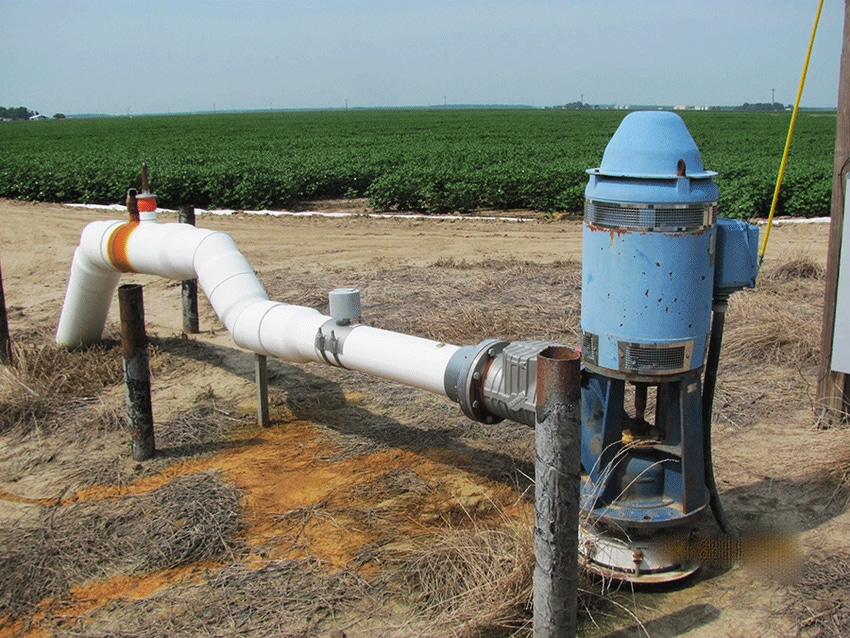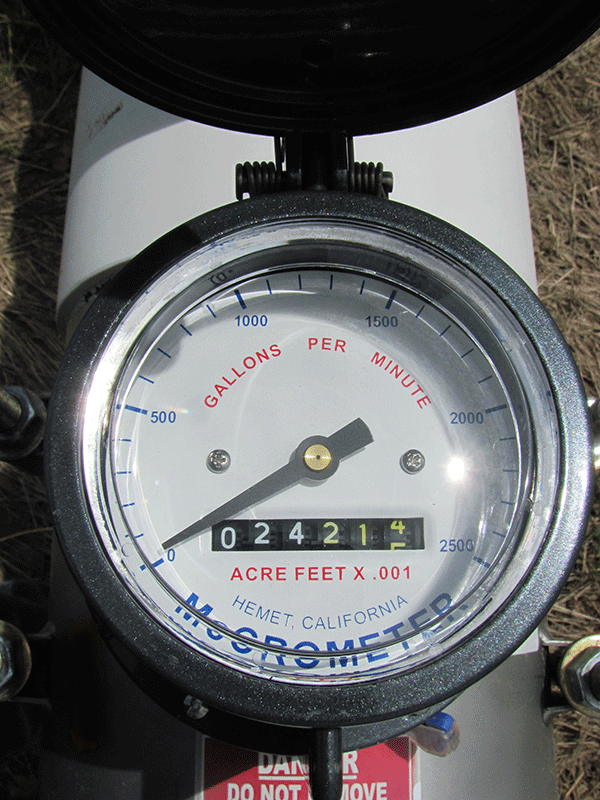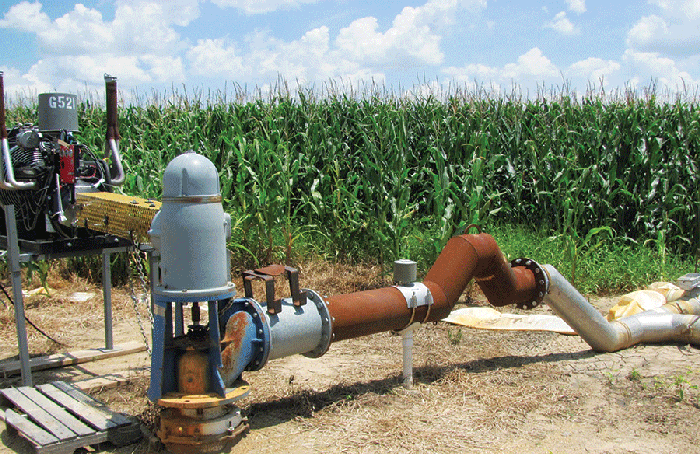
A flowmeter is the most important tool in an irrigator’s toolbox, says Paul Rodrigue. “But if you’re new to flowmeters, they unfortunately can become just a static piece of equipment rather than an integral part of understanding and improving irrigation efficiency on the farm.”
The device provides two basic pieces of information, says Rodrigue, who is supervisory engineer for Area 4 of the USDA National Resources Conservation Service at Grenada, Miss. They are (1) pumping rate, typically in gallons per minute (gpm), or cubic feet per second (cfs), the equivalent of a car speedometer’s miles per hour, and (2) totalizer, typically in acre feet (with a multiplier), or gallons (with a multiplier), the equivalent of your car’s odometer, showing miles driven. “These two pieces of information can be used in various ways to evaluate basic information about your irrigation system,” he says, and suggests the following steps that will guide your progress in the use of flowmeter information.
Step 1: Flow rate of your water source
“The most important piece of information from the flowmeter is how much water in flowrate (gpm) you are getting from your water source,” Rodrigue says. Factors that can be used to evaluate this include:
(a) The actual pumping capacity (gpm). Evaluate yearly, season-long changes due to water table drawdown, pump wear, and aquifer decline. Keep a yearly record as a minimum.
(b) Number of acres this flowrate will actually support: - 15 gpm/acre for rice, 10 gpm/acre for furrow, 5 gpm/acre for pivots. Note: 5 gpm is 0.24 inches per day per acre
(c) Primary input for poly-pipe hole sizing (e.g. PipePlanner) and re-nozzling pivots. Note: If a field riser is more than 660 feet from the water source, a separate flow measurement should be made due to line friction loss and reduced flow.
(d) Determining required time of pumping for an irrigation:
e.g., a pump at 1800 gpm= 4 cfs = 4 ac-in/hour
40 acres of rice needing 2 inches of water = 80 ac-in
80 ac-in/4 ac-in/hour = 20 hours of pumping (set a timer or pump automation alarm to this)
Important conversions: 450 gpm = 1 cubic feet per second (cfs) = 1 acre-inch/hour; 27,000 gallons = 1 acre-inch of water
“Be sure your flowmeter is always in a full pipe flow condition to achieve proper measurements,” Rodrigue says. “You have to have enough back pressure, or physically have a rise downstream in the pipe, to insure full pipe flow.”
Step 2: Flow Totalizer
The second most important piece of information from the flowmeter, he says, is the total amount of water pumped (ac-ft or gallons) between two points in time (e.g., a field irrigation, one irrigation cycle, one season). “This requires a little more documentation if you’re doing it manually, but is simplified if using a flowmeter with telemetry.”
(a) Total season average pumping:
Reading 1 – reading 2 = season long volume pumped.
Convert volume pumped to ac-in
(1) gallons/27000 gal/ac-in = ac-in
(2) ac-ft * 12 in/ft = ac-in
Divide the calculated ac-in by acres irrigated from water source, and that provides average inches applied over the irrigated acres; e.g., reading 1- reading 2 = 51,840,000 gallons. 51,840,000 gallons/27000 gal/ac-in = 1,920 ac-in; 1,920 ac-in/160 ac = 12 in of water, on average, applied to 160 acres.
Note: if you came up with a large or small number, you may have not properly applied the flowmeter register multiplication factor correctly to the dial readings (e.g., gallons x 1000)
b) Single field pumping: Same as A above, but use the readings from the start and finish of an individual field (e.g., telemetry is a great bookkeeping tool).
Step 3: Maintaining your flowmeter
“Your flowmeter should operate at least three to five years without maintenance,” Rodrigue says. “With proper maintenance, a flowmeter should last 20 to 30 years.
High pumping rate meters may require more frequent maintenance. Delta flowmeters should always be ordered with overrun bearings.”
“Consider having maintenance done every five years, he suggests. “Pull the meter and send it off for maintenance during the non-growing season. Meter maintenance is like changing oil in your motors. Meter repair is like an engine overhaul. Contact your dealer or the manufacturer for maintenance options.”
Recognize issues that may warrant more frequent maintenance or repair, he says. “These include unusual noises, any condensation in the register, rate/totalizer functions not working, and water leaks.
Surface water measurement requires a meter designed and installed for surface water in order to shed minor debris, Rodrigue notes. “Be sure you have the correct type. Also if surface water intakes are not properly screened, excess debris can still damage or clog a surface water flowmeter.
“Following these steps will help insure that you use your flowmeter as an active tool in your Irrigation toolbox, that you achieve water and energy efficiencies and that you maintain or enhance productivity. A flowmeter needs your involvement as an irrigator to properly plan and evaluate irrigation in order to achieve desired goals of water conservation, irrigation efficiency, and energy efficiency, thereby reducing costs while maintaining or enhancing yield, with an overall goal of profitability.”
For the Delta as a whole, Rodrigue says, “greater participation in the Delta Voluntary Metering Program is needed. This voluntary reporting of water use assists the scientists, researchers, modelers, and water managers in properly assessing the groundwater condition and to plan for water strategies in the future. The goal is to have sufficient water supplies in the Delta to meet all needs. Talk to your local NRCS office about programs for financial assistance to install a flowmeter and other water conservation measures on your farm.”
Voluntary reporting of water use in the Delta assists scientists, researchers, modelers, and water managers in properly assessing the groundwater condition and to plan for water strategies in the future.
Additional Information for irrigators can be found at https://sites.google.com/site/msdeltairrigation
Other topics for irrigation flow meters that can be explored further include:
- Checking irrigation efficiency: (Qt=ad) (flow rate x time = area x depth of water applied)
- Irrigation system evaluation
- Improving set times: Irrigation software (e.g., Pipe Planner)
- Nozzle packages: promote uniformity of water application
- Pump plant performance: pump/pump column problems, power unit, excessive drawdown
- Irrigation well: pump column/well casing, Etc.
- Voluntary water use reporting – Delta Voluntary Metering Program
- Economics – Every gallon you pump has a cost. Why wouldn’t you want an accurate pumping volume?
About the Author(s)
You May Also Like




